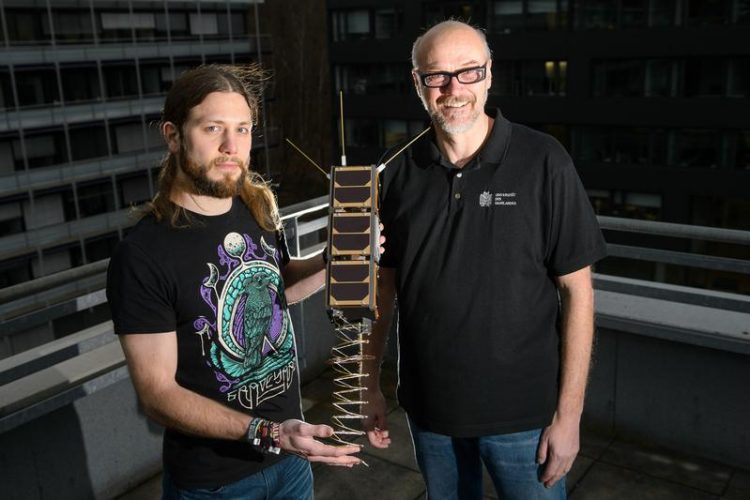From Space to the Streets: New Battery Model also Makes Electric Cars More Reliable

Gilles Nies and Professor Holger Hermanns with the replica of a nano satellite, whose performance can now be determined thanks to their research Oliver Dietze
“As far as we know, there is nothing like it in Earth orbit so far,” says Holger Hermanns, professor of Computer Science at Saarland University. In collaboration with his doctoral student Gilles Nies and student Marvin Stenger, Hermanns has developed a procedure that allows for far more accurate predictions of the amount of battery power needed for a particular operation in space.
Until now, space logisticians have tended to plan with overly large and heavy batteries, conceding valuable space needed for other equipment and experiments. “Amongst other things, not enough attention has been paid to the recovery effect, a phenomenon well-known from mobile phones.
If the phone dies due to an empty battery, it often takes just a few minutes of waiting, then you can turn the phone back on again and use it, for a short time at least,” Hermanns says.
The new battery model can be used to monitor the exact amount of energy currently available, and determine how much of it is present in chemically bound form, that is, not immediately usable. This lets the computer scientists calculate the probability of the battery being discharged at any given moment.
The Saarbruecken computer scientists’ findings can also be applied on Earth. “Batteries are ubiquitous – and a good battery model helps in a lot of situations,” says Holger Hermanns. Consider, for instance, the energy demands of an electric car: “So far, we could only answer the following question: Under ideal conditions, will the battery charge be enough for this electric car to make it to Frankfurt Airport? Now we can see whether the air conditioning system can be operated in such a way that you have a chance greater than 99 percent at all times to make it to your plane in time with the current charge”, explains Hermanns.
Further Information:
Group website “Dependable Systems and Software”:
http://depend.cs.uni-sb.de/
Press photos are available free of charge at www.uni-saarland.de/pressefotos.
Please observe the terms of use.
Media Inquiries:
Professor Holger Hermanns
Dependable Systems and Software
Saarland University
Phone: +49 681 302-5631
E-Mail: hermanns@cs.uni-saarland.de
Editor:
Gordon Bolduan
Competence Center Computer Science Saarland
Phone: +49 681 302-70741
E-Mail: bolduan@mmci.uni-saarland.de
Media Contact
All latest news from the category: Trade Fair News
Newest articles

First-of-its-kind study uses remote sensing to monitor plastic debris in rivers and lakes
Remote sensing creates a cost-effective solution to monitoring plastic pollution. A first-of-its-kind study from researchers at the University of Minnesota Twin Cities shows how remote sensing can help monitor and…

Laser-based artificial neuron mimics nerve cell functions at lightning speed
With a processing speed a billion times faster than nature, chip-based laser neuron could help advance AI tasks such as pattern recognition and sequence prediction. Researchers have developed a laser-based…

Optimising the processing of plastic waste
Just one look in the yellow bin reveals a colourful jumble of different types of plastic. However, the purer and more uniform plastic waste is, the easier it is to…



